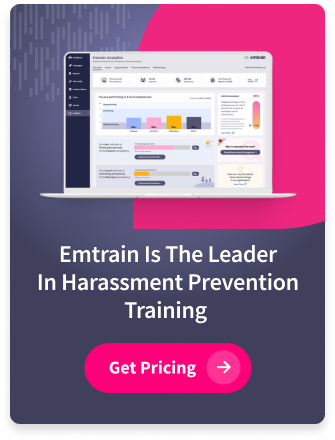The Training Paradox: High Completion Rates, Persistent Problems
Every HR leader has experienced this frustration: harassment prevention training shows 100% completion rates, yet investigations continue. Employees attend required sessions, pass assessments, and acknowledge policies—then fail to recognize harassment when it occurs, mishandle complaints when reported, or create hostile environments despite “knowing better.”
This disconnect reveals a fundamental flaw in how most organizations approach harassment prevention. According to EEOC data on workplace harassment charges, claims remain stubbornly consistent despite increased training investments. Traditional training excels at conveying definitions and legal standards but fails to build the judgment and skills employees need when facing ambiguous real-world situations. The result? Organizations achieve compliance with training mandates while remaining vulnerable to the very incidents that training should prevent.
Why Traditional Harassment Prevention Training Falls Short
Understanding these limitations clarifies why scenario-based approaches deliver superior outcomes:
Awareness Doesn’t Equal Skill Development
Most harassment prevention programs focus on defining protected classes, explaining legal standards, and listing prohibited behaviors. While employees need this foundational knowledge, awareness alone doesn’t prepare them to navigate nuanced situations—recognizing subtle harassment patterns, addressing inappropriate comments without escalating conflict, or supporting colleagues who experience harassment.
Generic Examples Don’t Reflect Real Workplace Dynamics
Training featuring obvious harassment examples (explicit propositions, overt discrimination) fails to prepare employees for the ambiguous situations they’ll actually encounter: jokes that target protected characteristics, exclusionary behavior disguised as team dynamics, or retaliation that’s rationalized as legitimate business decisions.
Passive Learning Doesn’t Change Behavior
Watching videos or reading policy explanations rarely influences how employees respond under pressure. Behavioral change requires practice making decisions, experiencing consequences, and receiving feedback—elements absent from passive training formats.
How Scenario-Based Training Builds Harassment Prevention Capabilities
Effective scenario-based harassment prevention programs address these shortcomings through several design principles:
Realistic Situations That Reflect Your Workplace Culture
Instead of generic examples, sophisticated programs present scenarios grounded in your industry, organizational dynamics, and actual risk patterns. Technology employees encounter scenarios about exclusion in engineering teams; healthcare workers navigate patient harassment; retail managers address customer behavior that crosses lines. This authenticity increases engagement and transfer to real situations. Learn more about Emtrain’s harassment prevention training tailored to your industry.
Decision Points That Require Judgment, Not Just Rule Recitation
Well-designed scenarios don’t ask “Is this harassment?” They present complex situations and ask “What would you do?” Multiple response options represent actual choices employees face—direct confrontation, reporting to HR, discussing with the person privately, seeking advice from colleagues. Feedback explains why certain responses prevent escalation while others enable continued harassment.
Manager-Specific Training That Addresses Unique Responsibilities
Managers face harassment prevention challenges distinct from individual contributors: investigating complaints fairly, addressing behavior without creating retaliation, balancing confidentiality with transparency, and creating psychologically safe teams. Scenario-based manager training should reflect these complexities, building skills through practice with realistic complaints, policy interpretation challenges, and team dynamic issues. Explore manager training best practices for harassment prevention.
Comparing Training Approaches: What Research and Data Reveal
Organizations implementing scenario-based harassment prevention training report measurably different outcomes compared to traditional approaches:
Behavioral Indicators Show Meaningful Improvement
Scenario-based training participants demonstrate better recognition of harassment patterns, more consistent reporting of incidents, and more effective bystander interventions. Analytics measuring how employees respond to realistic scenarios show improved judgment over time—a metric impossible to capture through traditional completion-based measurement. Research from Project Implicit demonstrates that behavioral interventions outperform awareness training in reducing bias.
Investigation and Complaint Data Reflect Prevention Success
Organizations using scenario-based training experience shifts in complaint patterns: more early-stage concerns raised before escalation, increased manager involvement in informal resolution, and fewer retaliation claims. These patterns suggest employees and managers develop confidence handling issues proactively rather than waiting for formal investigations.
Cultural Impact Extends Beyond Legal Compliance
While all harassment prevention training satisfies legal requirements, scenario-based approaches influence broader culture. Employees report increased confidence addressing microaggressions, greater willingness to support colleagues, and improved trust that concerns will be taken seriously—cultural factors that prevent harassment more effectively than fear of consequences alone.
Implementation Strategies for HR Leaders
Transitioning to scenario-based harassment prevention training requires thoughtful planning:
Start With Manager Training to Build Organizational Capability
Managers represent your frontline harassment prevention infrastructure. Implement scenario-based training for managers first, building their capacity to model appropriate behavior, address concerns early, and create team environments where harassment is less likely. Manager capability influences team culture more powerfully than individual contributor training.
Customize Scenarios to Your Industry and Risk Profile
Generic harassment training rarely resonates. Invest in programs that present scenarios relevant to your workplace: customer-facing roles handling client harassment, remote teams navigating online communication challenges, or highly collaborative environments addressing exclusion dynamics.
Measure Beyond Completion: Assess Judgment and Skill Application
Implement assessments that evaluate whether employees can apply harassment prevention principles to novel situations, not just recall definitions. Track scenario response patterns to identify departments or roles needing additional training or management coaching.
Integrate Training With Broader Culture-Building Initiatives
Scenario-based harassment prevention training should complement—not replace—broader inclusion and respect initiatives. Connect training content to your reporting mechanisms, investigation protocols, and manager accountability systems, creating consistency between what employees learn and what they experience. Review California’s SB 1343 requirements as a model for comprehensive harassment prevention approaches.
Addressing the Practical Challenges: Time, Cost, and Employee Resistance
HR program managers consistently cite three obstacles to implementing more sophisticated training:
Resource Constraints and Budget Limitations
Scenario-based training requires greater upfront investment than generic video courses. However, the total cost of harassment—investigations, legal fees, turnover, reputational damage—far exceeds training investments. Frame the business case around risk mitigation and compare costs against a single investigation or settlement.
Employee Fatigue and Training Resistance
Employees resist lengthy, repetitive harassment training. Scenario-based approaches can actually reduce this resistance by making training more engaging and clearly relevant. Shorter, focused scenarios that respect employee time perform better than marathon annual sessions.
Administrative Complexity
More sophisticated training may require updated technology platforms or reporting systems. However, modern learning management systems streamline administration while providing better measurement and documentation—capabilities that reduce long-term administrative burden.
The Strategic Imperative: Building True Prevention Capability
Effective harassment prevention isn’t achieved through annual training checkboxes—it requires building organizational capability to recognize, address, and prevent harassment throughout your culture. Scenario-based training represents a strategic investment in that capability, developing employee judgment, manager skills, and bystander confidence that traditional awareness programs cannot deliver.
For HR leaders committed to creating genuinely inclusive, respectful workplaces rather than simply achieving compliance, scenario-based harassment prevention training provides a proven methodology that changes behavior, reduces incidents, and builds the cultural foundation where harassment becomes less likely.
Strengthen Your Harassment Prevention Program
Contact us about our Harassment Prevention Training Course for a framework that builds manager skills and employee capability beyond basic compliance.








